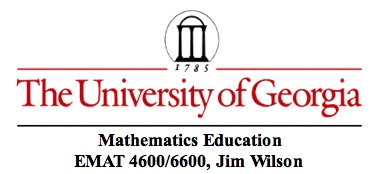

Exploration
Consider any triangle ABC. Select a point P inside the triangle and draw line AP, BP, and CP extended to their intersections with the opposite sides in points D, E, and F respectively.
Build a GSP file Explore (AF)(BD)(CE) and (FB)(DC)(EA) for various triangles and various locations of P. Or, use this GSP construction and Drag vertices or point P.
What conjecture might be made?
Given a triangle ABC with an arbitrary point P inside the triangle. Any segment from a vertex to the intersection with the opposite side is called a Cevian. Let D, E, and F be the feet of the Cevians opposite A, B,and C respectively. GSP file?
Prove:
Ceva's Theorem
If the three Cevians AD, BE, and CF are concurrent at P, then prove
Converse.
If
then the Cevians AD, BE, and CF are concurrent.
Hint:
Most proofs of this theorem in textbooks and out on the web construct auxiliary lines to develop similar triangles. A far simpler proof can be developed from the fact that areas with the same altitude are proportional to the lengths of the bases. You are encouraged to find an area proof.
GSP File IF NEEDED. Try to find a proof first.
Extension:
Can the result be generalized (using lines rather than segments to construct triangle ABC) so that point P can be outside the triangle? Show a working GSP sketch.
Extension:
Show that when P is inside triangle ABC, the ratio of the areas of triangle ABC and triangle DEF is always greater than or equal to 4. When is it equal to 4?
Extension:
Use Ceva's theorem to prove that the medians of a triangle are concurrent.
Explore other concurrency theorems that could be proved using Ceva's threorem.
a. Internal angle bisectors
b. Bisectors of the external angles on a side and the internal angle bisector of the opposite angle.
c. Lines of perpendiculars from each vertex to the line of the opposite side.

d. The perpendicular bisectors of the sides
e. Others?
e.g. lines from a vertex to point of tangency of incircle on the opposite side